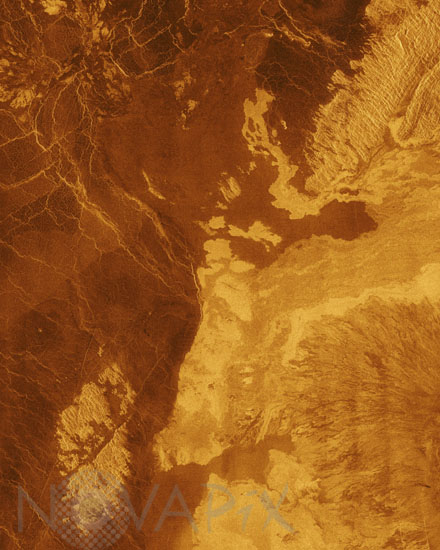Photo Agency - Astronomy - Space - Nature

Venus by Magellan: portion of Bereghinya Planitia
author: Nasa/JPL/Novapix
reference: a-ven06-00033
Image Size 300 DPI: 29 * 37 cm
This false color Magellan image shows a portion of Bereghinya Planitia (plains) in the northern hemisphere of Venus, centered at 31 degrees north latitude, 43 degrees east longitude. The area is 260 kilometers (160 miles) wide and 330 kilometers (200 miles) long. This image contains examples of several of the major geologic terrains on Venus and illustrates the basic stratigraphy or sequence of geologic events. The oldest terrains appear as bright, highly-fractured or chaotic highlands rising out of the plains. This is seen in the upper right and lower left quadrants of the image. The chaotic highlands, sometimes called tessera, may represent older and thicker crustal material and occupy about 15 percent of the surface of Venus. Plains surround and embay the fractured highland tessera. Plains are formed by fluid volcanic flows that may have once formed vast lava seas which covered all the low lying surfaces. Plains comprise more than 80 percent of the surface of Venus. The most recent activity in the region is volcanism that produced the radar bright flows best seen in the lower right quadrant of the image. The lava flows in this image are associated with the shield volcano Tepev Mons whose summit is near the lower left corner of the image. The flows are similar to the darker plains volcanics, but apparently have more rugged surfaces that more efficiently scatter the radar signal back to the spacecraft. The geologic sequence is early fracturing of the tessera, flooding by extensive plains lavas and scattered, less extensive individual flows on the plains surface. The simulated hues are based on color images recorded by the Soviet Venera 13 and 14 spacecraft.
Keywords for this photo:
1991 - ASTRONOMY - BEREGHINYA PLANITIA - FALSE COLOR - LAVA - MAGELLAN - PLANET - RADAR - VENUS -
Contact : Stéphane Aubin +33-(0)9-51-26-53-76
© Novapix - All rights reserved


